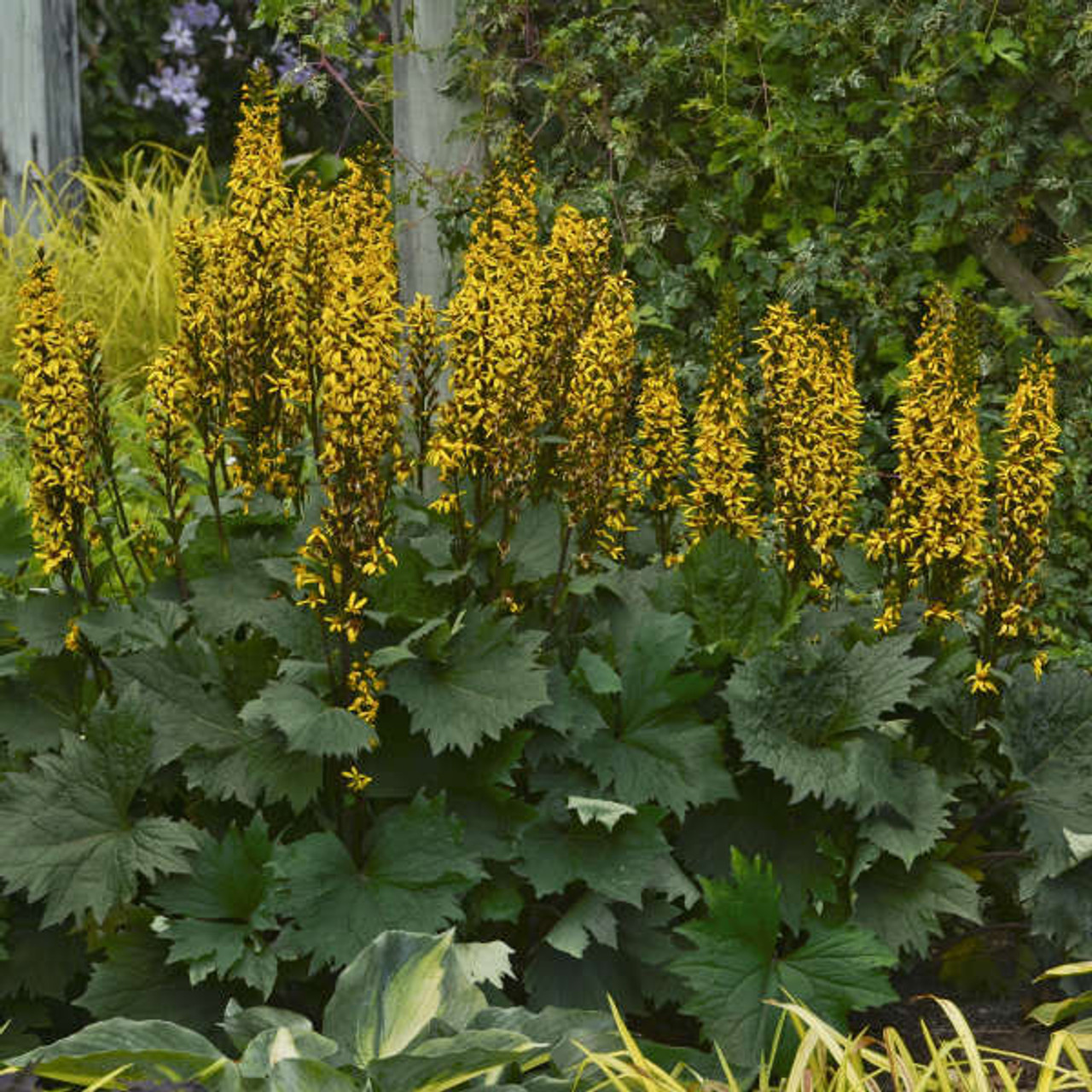Product Description
Ligularia 'Bottle Rocket' PP24486 (30)ct Flat
Common Name: Dwarf Ligularia, leopard plant.
Mustard yellow flowers are held on chocolate stems just at the top of the dense clump of foliage so no naked stems are showing. The flowers are held like a bouquet in the center of the clump, and there are more flowering stems per plant than its parent. 'Bottle Rocket' is about 6 inches shorter than its parent in full bloom. 'Bottle Rocket' is also a more robust plant with thicker, very large, serrated leaves and a denser habit.
- More compact sport of 'Little Rocket' that delivers excellent garden performance
- Perfectly proportioned plant
Height: 28.0-34.0 Inches
Spread: 24.0-28.0 Inches
Hardiness Zones: 4,5,6,7,8,9
Flower Color: Yellow Shades
Foliage Color: Green shades
Part Shade (4-6 hrs. Direct Sun)
Consistent Water Needs
Average to Fertile Soil Quality
Bloomtime: Midsummer
Attracts Butterflies
Bee Friendly
Deer Resistant
Growth Rate: Medium
Bog Plant, Border Plant, Container, Cut Foliage, Mass Planting, Specimen, Focal Point
Ligularia 'Bottle Rocket' is a striking perennial that adds bold texture and vibrant color to shady gardens. It is a Proven Winners variety known for its compact habit, abundant flowers, and attractive foliage. Here is a closer look at its key features:
Appearance:
- Mustard Yellow Flowers: 'Bottle Rocket' produces tall, slender spikes of bright mustard yellow flowers in mid to late summer. The flowers resemble bottle rockets shooting upwards, creating a captivating display.
- Serrated Foliage: The flowers rise above a dense clump of large, serrated, dark green leaves, adding a bold texture to the garden.
- Compact Habit: This cultivar has a more compact habit compared to other Ligularia varieties, typically reaching about 28 to 34 inches tall and 24 to 28 inches wide.
Growing Conditions:
- Shade: Thrives in partial shade to full shade. It prefers some shade during the hottest part of the day to prevent the leaves from scorching.
- Moist Soil: Prefers consistently moist, fertile soil. It is a good choice for rain gardens, bog gardens, or areas that tend to stay damp.
- Hardiness Zones: Suitable for USDA hardiness zones 4-9, making it a versatile choice for many gardeners.
Care:
- Watering: Keep the soil consistently moist, especially during dry periods.
- Fertilizing: Fertilize in spring with a balanced fertilizer or compost to promote healthy growth and flowering.
- Deadheading: Deadheading spent flower spikes can encourage additional blooms and maintain a tidy appearance.
Uses:
- Shade Gardens: Adds a bold and colorful accent to shade gardens.
- Borders: Can be used as a background plant in borders, adding height and texture.
- Water Features: Its tolerance for moist soils makes it a good choice for planting near streams or ponds.
- Containers: Can be grown in containers to add a dramatic touch to shaded patios or balconies.
Additional Information:
- Attracts Pollinators: The flowers attract butterflies and bees.
- Deer Resistant: Deer tend to avoid Ligularia.
- Compact Size: 'Bottle Rocket' is a more compact Ligularia variety compared to many others, making it suitable for smaller gardens.
If you are looking for a bold and beautiful perennial with vibrant yellow flowers, attractive foliage, and a compact habit, Ligularia 'Bottle Rocket' is an excellent choice. It is a striking addition to any shade garden.
Thirty (30) plants per flat (or tray). Approximate Plug Measurements: 3 inches deep x 2 inches wide.
Other Details
The most important part of the plant is its root system. Healthy roots are the foundation of a healthy, vibrant plant. The type of plug container used is based on the specific needs of the plants. Perennials offered as bare root traditionally perform better when planted as bare root.Planted in a specialized mix, potted plants have well established root systems. Top growth stage will vary depending on the current life cycle and time of year when shipped. In Winter and early Spring dormant plants may be shipped. Dormant plants may be planted right away, even before the last frost date.
Most bare root varieties are field grown for at least one season, though Hemerocallis and Hosta are grown for two seasons. The bulk of the soil is removed during the harvesting process and the tops of most varieties are trimmed back to the crown. They are graded, packed in shredded aspen or sphagnum moss and stored in freezers until ready to be shipped.
See our Container Sizes and Bare Root Perennials pages for more information.
Plant information and care is provided in the Overview section, Plant Genus Page and general information is provided in the Planting Care & Guides. Additional questions can be asked on each Plant page.
Plant Spacing: Using the maximum mature spread or width of a plant to guide spacing, ensures space to grow to full size. To fill an area sooner, plant them closer together. Just remember, future thinning or transplanting may be needed.
Water: Keep a close eye on newly planted perennials, especially throughout the first growing year. Most early plant loss is due to too much or too little water!













